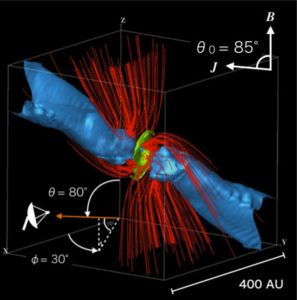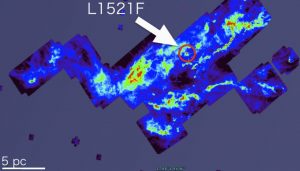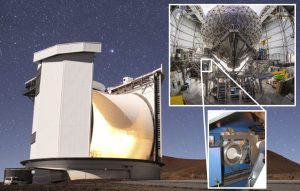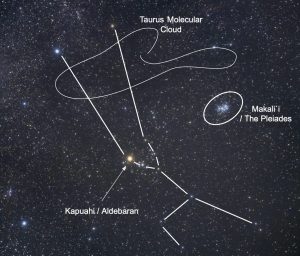Maunakea Hawaiʻi – JCMT astronomers studying a stellar nursery in the Taurus constellation have discovered a young dense cloud core that is in the early stages of star formation. Using observations from the JCMT and combining them with special (MHD, Magnetohydrodynamic) numerical simulations, the team was able to obtain a unique view of this star forming core called L1521F (see Figure 1).

Figure 1. Three-dimensional computer generated view of magnetic field lines (red lines), a pseudo-disk and high-density region (green surface) and out-flow (blue surface). This image enables astronomers studying the star forming core L1521F to have a greater understanding of the physical processes. In particular the (red) magnetic field lines are seen to be twisted around by the (green) high density region.
Astronomer Dr. Hiroko Shinnaga who lived and worked in Hilo, Hawaii for 11 years and was a key member of the team said “It is really exciting! These JCMT observations are capturing the moment that a star is being formed.” A computer generated model of the core has been released and is featured on the cover of the Publications of the Astronomical Society Japan (PASJ) journal of February 2023 (see Figure 1). Discussing the work, Hiroko said “When you look at the computer simulated image you see the magnetic field lines (red) are dragged by gravity along with the dust and gas. The green is the disk of the baby star (protostar) that will eventually evolve into something similar to our solar system. This green disk will create planets and moons around the baby star (like our Sun). The elongated blue feature is the so-called ‘bipolar outflow’ that is a natural byproduct of the star formation process.”
The particular star forming core, L1521F, was selected for the study by the team due to its location in the Taurus molecular cloud – a nearby star-forming cloud that harbors young stars similar in mass to our own Sun. The cloud is dark at optical wavelengths but shines brightly at submillimeter wavelengths (See Figure 2). Unlike other regions of star formation, Taurus is relatively quiet and calm with no interference from nearby massive sibling stars – enabling astronomers to study individual young stars in more detail.

Figure 2. Herschel 250 micron image of the Taurus Molecular cloud with the location of L1521F indicated. At this wavelength the cold dense dusty region shines brightly. Credit: André et al. 2010.
When asked about what makes this work unique Hiroko responded “for the first time we are able to see all the ingredients in action in forming a baby star inside L1521F – that’s very tough unless you have a telescope like the JCMT and an instrument like POL-2”. The instrument POL-2, measures the polarization of the incoming light and works with a 10,000 pixel submillimeter camera called SCUBA-2 (see Figure 3). POL-2 enables astronomers to detect magnetic fields in space at submillimeter wavelengths, a relatively new area of research in the field of star formation. POL-2 makes such sensitive measurements that it requires extraordinarily stable atmospheric conditions which makes the JCMT on Maunakea in Hawaiʻi vital for such work.
Dr. Harriet Parsons, Head of Operations at the JCMT commented “What is particularly exciting for myself as an observational astronomer is to see how we can combine the beautiful data taken with the JCMT with these powerful theoretical models. On Earth we have only one view of the cosmos, we generally cannot move closer to the objects we wish to study. These models allow us to explore the cosmos like we might experiment with a recipe in the kitchen, changing the ingredients until the model comes out just the way we see the object in the sky. It’s really exciting and a testament to the hard work of all of the team. I hope JCMT will be able to provide the team with more fantastic data in the future.“
As for the future, the team intends to study more regions like L1521F to see what is typical for such star forming cores. “Astronomers use SCUBA-2/POL-2 at JCMT to push forward to understand our Universe and our origin in the Universe.” said Hiroko “Understanding the star formation process is also essential to know how our material-rich planet, the Earth, is created. It’s incredibly exciting”.

Figure 3. Main: The JCMT, Maunakea Hawaiʻi. Top right: The interior view of the JCMT. Bottom right: the POL-2 polarimeter. Credit: William Montgomerie, Harriet Parsons, EAO/JCMT.
For those interested, the constellation Taurus is currently visible in the night sky overhead in Hawaiʻi after sunset. For those more familiar with Hawaiian starlines, the molecular cloud referenced in this work is located in Ke Kā o Makali`i (the Bailer of Makali`i) close to Makali`i (see Figure 4).

Figure 4. Optical image indicating the location of the Taurus Molecular Cloud (dark at visible wavelengths) where the L1521F cloud core is located. Credit: Akira Fujii/David Malin Images ©.
Further information
This work was published in PASJ: “Twisted magnetic field in star formation processes of L1521 F revealed by submillimeter dual-band polarimetry using the James Clerk Maxwell Telescope” by Sakiko Fukaya, Hiroko Shinnaga, Ray S. Furuya, Kohji Tomisaka, Masahiro N. Machida, and Naoto Harada. An online video explaining the work in more detail may be viewed here.
With credit to the following institutions:
Physics and Astronomy Department, Graduate School of Science and Engineering, Kagoshima University, Japan. Amanogawa Galaxy Astronomy Research Center (AGARC), Graduate School of Science and Engineering, Kagoshima University, Japan. Institute of Liberal Arts and Sciences, Tokushima University, Japan. National Astronomical Observatory of Japan. Department of Earth and Planetary Sciences, Faculty of Sciences, Kyushu University, Japan.
Computational power
The special (MHD, Magnetohydrodynamic) numerical simulations require a vast computational effort. The team calculated 9 models and chose the model that best fitted to observations of L1521F. Each model requires about 40,000 CPU hours using a vector type supercomputer. After the models are created polarization and intensity distributions are created for 24 different viewing angles.
Related work
“Misalignment of magnetic fields, outflows, and discs in star-forming clouds” Masahiro, Shingo and Hideyuki 2020 MNRAS https://ui.adsabs.harvard.edu/abs/2020MNRAS.491.2180M/abstract
About the James Clerk Maxwell Telescope
Operated by the East Asian Observatory, the James Clerk Maxwell Telescope (JCMT) is the largest astronomical telescope in the world designed specifically to operate in the submillimeter wavelength region of the spectrum. The JCMT has a diameter of 15 meters and is used to study our Solar System, interstellar and circumstellar dust and gas, and distant galaxies. It is situated near the summit of Maunakea, Hawai‘i, at an altitude of 4,092 meters.
The East Asian Observatory is a collaboration between our partner regions in China, Japan, Korea, Taiwan, Thailand, United Kingdom, Canada, Hong Kong, Vietnam, Malaysia, and Indonesia. Click here for more information.
The East Asian Observatory wishes to recognize and acknowledge the very significant cultural role and reverence that the summit of Maunakea has always had within the indigenous Hawaiian community. We are most fortunate to have the opportunity to conduct observations from this mountain.
Contacts
Dr. Harriet Parsons, JCMT Head of Operations, EAO/JCMT h.parsons@eaobservatory.org
Dr. Hiroko Shinnaga, shinnaga@sci.kagoshima-u.ac.jp



